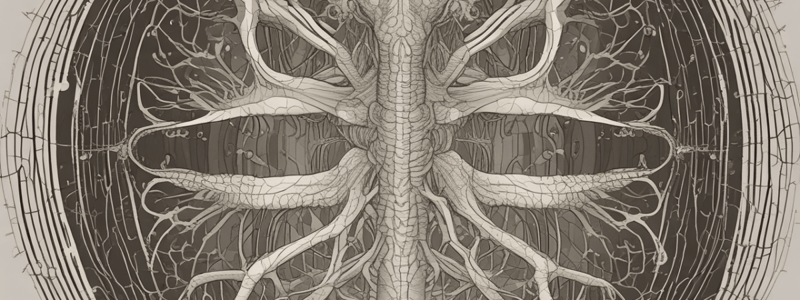Podcast
Questions and Answers
Which division of the nervous system provides autonomic regulations of cardiac muscle, smooth muscle, glands, and adipose tissue?
Which division of the nervous system provides autonomic regulations of cardiac muscle, smooth muscle, glands, and adipose tissue?
- Visceral motor division (correct)
- Sympathetic division
- Somatic sensory division
- Somatic motor division
What is the primary purpose of a neuro exam?
What is the primary purpose of a neuro exam?
- To observe the patient's level of consciousness
- To diagnose a specific disease
- To localize the problem (correct)
- To prescribe medication
The sensory afferent division can be directly further divided into which of the following pairs?
The sensory afferent division can be directly further divided into which of the following pairs?
- Visceral sensory and Somatic sensory (correct)
- Visceral motor and Somatic sensory
- Visceral motor and Somatic motor
- Motor efferent and Sensory sympathetic
Which of the following is a function of the somatic sensory division?
Which of the following is a function of the somatic sensory division?
What is the function of the parasympathetic division?
What is the function of the parasympathetic division?
The PNS can be directly further divided into which of the following pairs?
The PNS can be directly further divided into which of the following pairs?
Which division of the nervous system controls skeletal muscle contractions?
Which division of the nervous system controls skeletal muscle contractions?
What is the primary function of the brain in the central nervous system?
What is the primary function of the brain in the central nervous system?
Which of the following is NOT a location where a neurological issue can be localized?
Which of the following is NOT a location where a neurological issue can be localized?
The visceral motor division can be directly further divided into which of the following pairs?
The visceral motor division can be directly further divided into which of the following pairs?
What is the role of the spinal cord in the central nervous system?
What is the role of the spinal cord in the central nervous system?
What is the function of the sympathetic division?
What is the function of the sympathetic division?
The motor efferent division can be directly further divided into which of the following pairs?
The motor efferent division can be directly further divided into which of the following pairs?
What is the visceral sensory division responsible for?
What is the visceral sensory division responsible for?
What is the difference between a hands-off and hands-on neuro exam?
What is the difference between a hands-off and hands-on neuro exam?
What is the primary function of the sensory afferent division in the peripheral nervous system?
What is the primary function of the sensory afferent division in the peripheral nervous system?
What is the relationship between the CNS and the PNS?
What is the relationship between the CNS and the PNS?
What is the primary function of the motor efferent division in the peripheral nervous system?
What is the primary function of the motor efferent division in the peripheral nervous system?
What is the main difference between the visceral sensory division and the somatic sensory division?
What is the main difference between the visceral sensory division and the somatic sensory division?
Flashcards are hidden until you start studying
Study Notes
Nervous System: General Info
- The mammalian nervous system consists of two main subdivisions: Central Nervous System (CNS) and Peripheral Nervous System (PNS).
Central Nervous System (CNS)
- The CNS is composed of the brain and spinal cord.
- The CNS receives and processes information, stores memories, generates thoughts and emotions, and initiates responses.
- The brain is responsible for processing information and controlling responses.
- The spinal cord conducts signals to and from the brain and controls reflex activity.
Peripheral Nervous System (PNS)
- The PNS is composed of all neural bodies outside of the CNS, including receptors, nerves, and ganglia.
- The PNS connects the CNS to the limbs and organs of the animal.
- The PNS can be further divided into two main divisions: Sensory Afferent Division and Motor Efferent Division.
Sensory Afferent Division
- The sensory neurons bring information to the CNS from receptors in peripheral tissues and organs.
- The sensory afferent division can be further subdivided into Visceral Sensory Division and Somatic Sensory Division.
- The Visceral Sensory Division collects information about internal organs via visceral receptors and sensory neurons.
- The Somatic Sensory Division collects information about position, touch, pressure, pain, and temperature via somatic receptors and sensory neurons.
Motor Efferent Division
- The motor neurons carry commands from the CNS to the peripheral tissues and organs.
- The motor efferent division can be further subdivided into Visceral Motor Division and Somatic Motor Division.
- The Visceral Motor Division provides autonomic regulations of cardiac muscle, smooth muscle, glands, and adipose tissue, which are all under involuntary control.
- The Somatic Motor Division controls skeletal muscle contractions, which are under voluntary control.
- The Visceral Motor Division can be further subdivided into Sympathetic Division and Parasympathetic Division.
- The Sympathetic Division is known as the "fight or flight" autonomic response.
- The Parasympathetic Division is known as the "rest and digest" autonomic response.
Neuro Exam
- A hands-off neuro exam involves observing the patient's level of consciousness, content of consciousness, posture, and gait.
- A hands-on neuro exam involves observing the patient's cranial nerves, postural reaction, spinal nerves, and nociception.
- The overall purpose of any neuro exam is to localize the problem.
Studying That Suits You
Use AI to generate personalized quizzes and flashcards to suit your learning preferences.




